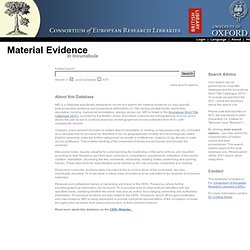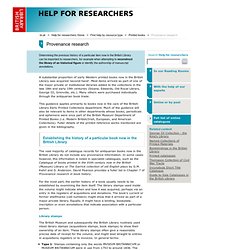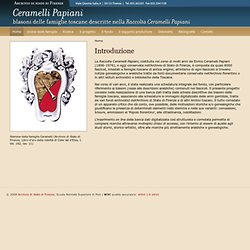

Material Evidence in Incunabula. MEI is a database specifically designed to record and search the material evidence (or copy specific, post-production evidence and provenance information) of 15th-century printed books: ownership, decoration, binding, manuscript annotations, stamps, prices, etc.

MEI is linked to the Incunabula Short Title Catalogue (ISTC), provided by the British Library, from which it derives the bibliographical records, and it allows the user at last to combine searches of bibliographical records (extracted from ISTC) with copyspecific records. Uniquely, every element recorded (a certain style of decoration or binding, a manuscript note, etc.) is treated as a valuable clue for provenance, therefore it can be geographically located and chronologically dated.
Explicit ownership notes are further categorised as private or institutional, religious or lay, female or male, and by profession. Index possessorum incunabulorum [CERL] ProBok. Provenance - Yale Law Library - Rare Books Blog. Yale Law Library - Rare Books Blog All Tags » Provenance ( RSS ) A trophy of the War of 1812 Earlier this week -- August 19, to be exact -- was the 200th anniversary of one of the U.S. Navy's most famous battles, the victory of the U.S.S.
Constitution over the H.M.S. A trophy from that battle resides in the Yale Law Library's Rare Book Collection. "These volumes were ordered by J. Provenance research (The John Rylands University Library - The University of Manchester) Provenance, or the history of ownership, of individual books and collections is a growing area of research.

Allied to this is an increasing interest in the use of books during their lifetimes, in the cultures and practices of reading, and in the history of book-collecting. Anyone interested in the provenance of the Library’s printed collections should first consult the online catalogue, which contains provenance information for many Special Collections books. Currently there isn’t a separate search field for former owners, so you will need to use the author field instead. The Library’s own archives contain a great deal of information on the history of our collections.
There are various manual records of provenance, including accession registers, and sheaf catalogues of inscriptions, bookplates, armorial bindings and illuminated arms. There are also excellent reference collections of bookplate literature and binding literature. Provenance research help BL. A substantial proportion of early Western printed books now in the British Library was acquired 'second-hand'.

Most items arrived as part of one of the major private or institutional libraries added to the collections in the late 18th and early 19th centuries (Sloane, Edwards, Old Royal Library, George III, Grenville, etc.). Many others were purchased individually through the antiquarian book trade. This guidance applies primarily to books now in the care of the British Library Early Printed Collections department. Much of the guidance will also be relevant to items in other departments whose books, periodicals and ephemera were once part of the British Museum Department of Printed Books (i.e.
Provenance des livres anciens BM Lyon. Deutsch English Imprimés à partir du milieu du 15e siècle, de nombreux livres anciens portent la marque des personnes ou institutions à qui ils ont appartenu : reliure armoriée, ex-libris, notes de lectures, etc. Parallèlement au catalogue des collections de la bibliothèque qui propose une description complète de ces ouvrages, la base d’images numériques "Provenance" contient la reproduction des marques permettant d’établir l’itinéraire géographique et intellectuel des livres en identifiant leurs anciens possesseurs et lecteurs. Exlibris allemands. BSB.
The Latin term "exlibris" ("from the books") designates graphically printed sheets of mostly small format, which were stuck in books to indicate the owner, and which contained the name, the monogram or coat of arms of the owner or a pictorial representation referring to him or her.

The earliest exlibris are from the 15th century. The Bayerische Staatsbibliothek owns the third largest collection of exlibris in Germany. In addition to the exlibris detached from library holdings in the 19th and the early 20th century, the collection encompasses several private collections acquired by the library at a later time, among them the modern papers of the physician Josef Klüber (1873-1936) and the librarian Ernst Freys (1863-1956) as well as the collections of Rudolf Freiherr von Hoschek (1887-1960), Hans Wanger (*1898/99), Emil Sulger-Gebing (1863-1923) and Aloys Fischer (1880-1937). here. Blasoni fiorentini. Stemma della famiglia Ceramelli (Archivio di Stato di Firenze, Libro d'oro della nobiltà di Colle Val d'Elsa, I.

Vol. 182, tav. 11) Home La Raccolta Ceramelli Papiani, costituita nel corso di molti anni da Enrico Ceramelli Papiani (1896-1976), e oggi conservata nell'Archivio di Stato di Firenze, è composta da quasi 8000 fascicoli, intestati a famiglie toscane di antica origine; all’interno di ogni fascicolo si trovano notizie genealogiche e araldiche tratte da fonti documentarie conservate nell'Archivio fiorentino o in altri istituti archivistici e biblioteche della Toscana. Nel corso di vari anni, è stata realizzata una schedatura integrale del fondo, con particolare riferimento ai blasoni (ossia alle descrizioni araldiche) contenuti nei fascicoli.
E-Bibliophilie archives de ventes aux enchères.